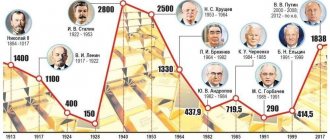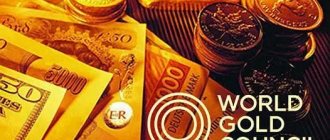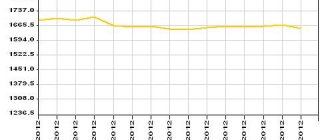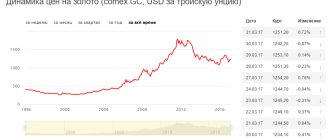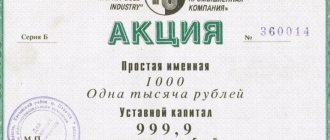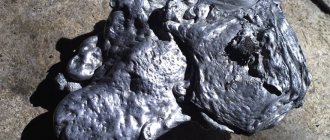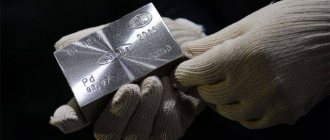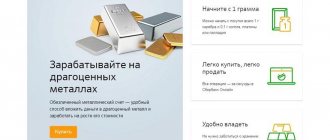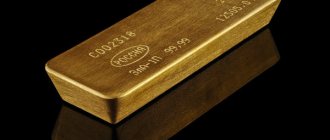Most currencies in the modern world are not tied to gold reserves, this also applies to the Russian ruble. The gold reserve available in our country today can provide only a few percent of the ruble. The situation can only be changed by radically restructuring the economy, which is very, very difficult to do, especially in a situation where the usefulness of a full gold backing of the ruble remains in question.
The ruble today is not backed by gold, oil products, or anything else. Cases of the introduction of backing the national currency with gold have been observed in history, for example, such a standard was in force from the mid-19th century until 1944, and from 1944 to 1971 the Bretton Woods system worked, in which a number of currencies were pegged to the dollar, and then to gold. But today, the currencies of the main economies of the world are provided only by guarantees from the country’s Central Bank: it is he who guarantees that the currency serves as a means of payment.
Securing the ruble in our country
The silver ruble was introduced into circulation by Peter the Great. The very fact that it was minted from silver confirmed its solvency. The paper notes that appeared later were much less trusted and quickly depreciated. An attempt to link the ruble to a precious metal was made in the last third of the 19th century, when gold coins were minted. It was not necessary to use them specifically - they were freely exchanged for ordinary paper money in a 1:1 ratio. from this time until 1917, the ruble was backed by gold.
Naturally, the major political and economic crisis caused by the revolution also broke the established gold security system.
The very fact that the state currency is backed by gold is considered positive, but any currency can become quite stable without a direct link to gold. An example is the euro, which is not only not backed by gold, but is generally not tied to the economy of a single country, but at the same time it is not only completely stable, but also serves as a reserve world currency along with the dollar and is freely convertible into any other currency.
As for the Russian ruble, the main factors in securing it today are the receipt of dollars from the sale of oil and gas abroad. This allows the ruble to be relatively stable. However, the geopolitical situation forces us to return to the question of the need to back the ruble with gold again and again, or to stabilize the Russian currency in another way.
Ruble devaluation brings trillions: experts call a dangerous tool for filling the National Welfare Fund
Three funds in one
Over the years of its existence, the Russian reserve bank has gone through several mergers and renamings. The National Welfare Fund, which is now widely known, appeared only in 2021, although Russia began saving in reserve at the very beginning of the 2000s. This became possible when the country emerged from the crisis of the 1990s thanks to greatly increased oil prices. Before this, saving for a rainy day was out of the question: the state was mired in loans, the default devalued the ruble, and every penny was spent on urgent needs.
In the second half of 1999, a miracle happened: oil prices rose above $20 per barrel for the first time in several years. This made it possible to increase budget revenues and gain relative financial stability. According to the Ministry of Finance, in 2000, additional income from rising oil prices amounted to 300 billion rubles. In 2001, Vladimir Putin, at the instigation of then Finance Minister Alexei Kudrin, proposed creating a reserve where excess profits from oil sales could be put aside. So in 2004, the progenitor of the current National Welfare Fund appeared - the Stabilization Fund of Russia. This fund performed several functions: it provided additional stability to public finances and served as a source of financing for investment programs. In fact, these were assets that could be directly controlled by the government, and not by parliament approving the budget. The state decided to use the first savings as follows: in 2005, funds from the Stabilization Fund were used to pay off Russia’s external debt (to the International Monetary Fund and to the member countries of the Paris Club) and to cover the deficit of the Russian Pension Fund.
In 2006, Putin voiced the idea of transforming the Stabilization Fund. In his Budget Address (this happened before), the President proposed adopting a budget not for one, but for three years and, in connection with this, changing the structure of reserves. In 2008, the Stabilization Fund was abolished. It was divided into the Reserve Fund and the National Welfare Fund. At the time of the division, 3.85 trillion rubles remained in the Stabilization Fund. After the spin-off, the two foundations were assigned different functions. The reserve fund was intended to cover budget expenses in the event that energy prices dropped significantly, as well as to stabilize the economy during a crisis. The National Welfare Fund was needed to support the pension system. For example, voluntary pension savings of Russians were co-financed from it. True, then the functionality of the National Welfare Fund expanded, and the fund began to be used to finance infrastructure projects.
In 2021, Russia's double box was again awaiting transformation, but for a forced reason. In 2017, the Reserve Fund was completely depleted: it fulfilled its purpose and covered the budget deficit resulting from the 2014–2016 crisis. After this, the Reserve Fund ceased to exist: the National Welfare Fund took over all functions.
The National Wealth Fund is a standard reserving instrument for the purposes of managing financial and economic risks, as well as managing monetary circulation indicators within the country, explained Konstantin Ordov, Doctor of Economics, Professor of the Financial University under the Government of the Russian Federation, in an interview with MK.
“In general, a market economy in its classical form does not imply the need to form significant amounts of reserve funds, since in international trade free exchange rate formation makes it possible to balance the industrial and commercial potential of different countries. However, in countries with poorly diversified economies, such as Russia, the presence of social obligations and other non-sequestered (non-reduced) government expenditures makes it necessary to form reserves for a rainy day. Such a day is considered to be an economic crisis or a period of unfavorable global price conditions for the main product or product that forms the basis of the budget revenue,” he noted.
By the way, compared to other storage countries, Russia is in a very good position. The National Welfare Fund is included in the international reserves of the Russian Federation, although it has a number of restrictions on areas of use. If we compare the volumes of gold and foreign exchange reserves of states, at the end of the first quarter of 2021, Russia ranked 4th in the world with an amount of $565 billion. The most thrifty was China with $3.1 trillion, followed by Japan - with $1.4 trillion and Switzerland - with $989 billion
Reserves went into action
Where did the funds come from and how were they used? Additional income from oil sales above a certain level went to the Stabilization Fund. This money was invested in foreign currency and debt obligations. The Reserve Fund became the legal successor of the Stabilization Fund in this regard. It also received windfall profits from oil, then invested in foreign currency and debt obligations. At the same time, the volume of the fund could not exceed 10% of GDP (later 7%). When the Reserve Fund reached the maximum permitted level, the remaining excess income was accumulated by the National Welfare Fund. By the way, initially it had an even more pretentious name: the Fund for Future Generations. This name hinted at the original purpose of the National Welfare Fund - maintaining the pension system. But when the functions were expanded, the fund’s money was allowed to be spent on loans to banks, which were then supposed to return investment profits to the fund. Thus, the Crimean Bridge, the Central Ring Road in Moscow and the region, and the Moscow-St. Petersburg toll highway were built with loan funds from the National Welfare Fund. In a word, the principle of filling funds comes down to a simple formula: excess profits from the sale of oil go into the moneybox, which are invested in financial instruments or investments for even greater profits. This is a state-scale investment scheme.
The National Welfare Fund in the latest version was also filled with additional oil and gas revenues. The cut-off level was $42.2 per barrel of Urals. When “black gold” cost $60 and above, a lot of money went into the box. But in addition, Russia received income from managing the funds of the National Welfare Fund - that very investment. The management of the funds of the National Welfare Fund is carried out by the Ministry of Finance, and in some cases by the Central Bank. The Ministry of Finance processes the fund's funds in two ways. The first one invests in the purchase of currencies (Australian, Canadian and US dollars, euros, pound sterling, Swiss franc and yen). The second one places it in various assets: government bonds of foreign countries, debt obligations of international organizations, central banks, shares of Russian companies related to the implementation of infrastructure projects, deposits in banks and others.
Such a diversified investment portfolio brings dividends to the National Welfare Fund due to exchange rate differences. For example, the exchange rate difference from the revaluation of funds of the National Welfare Fund for the period from January 1 to April 30, 2021 amounted to 1 trillion 197 billion rubles. In turn, by placing funds in financial assets in the first four months of the year, the moneybox “earned” 9.175 billion rubles. It is thanks to this that the National Welfare Fund not only does not decrease during the crisis against the backdrop of record low oil prices, but also grows. From March to April this year, the National Welfare Fund grew by 4.2 trillion rubles, despite the average oil price in March–April fluctuating from $20 to $30 per barrel.
Here is the answer to the question why hydrocarbons depreciated in value, and the National Welfare Fund was filled: the moneybox swelled thanks to the ruble falling in price against the background of oil. A simple rule worked: if you invest in currency in time, you can make money on exchange rate differences.
“Despite the crisis and fears for the safety of the National Welfare Fund, in March 2020 it increased by 34% - to 12.9 trillion rubles. This was the result of the peculiarities of crediting funds to the fund’s accounts, which led to the same sharp increases in July 2021 - by 108%, in June 2018 - by 23%,” says Konstantin Ordov.
The devaluation of the ruble is a powerful tool for filling the National Welfare Fund, so there is no need to talk about the complete depletion of the money in the near future. “The current situation in commodity prices and the economy’s need for anti-crisis financial support measures do not allow us to count on comparable dynamics next year. But this does not mean that the volume of ruble funds of the National Welfare Fund will decrease next year. An increase in the dollar exchange rate by 10 rubles could additionally bring about 1.7 trillion rubles into the National Welfare Fund as exchange rate differences, which is so far significantly less than what the Russian Government spent on anti-crisis measures,” says Professor Ordov.
According to the expert, in recent decades it has generally become very fashionable and sometimes very effective to use reserve funds to manage the exchange rate. But it’s not in favor of the national currency. The “parade of devaluations” of 2015 and 2021 showed that few people are ready to use reserve funds to maintain an excessively strong exchange rate of the national currency,” our interlocutor noted.
Photo: Ivan Skripalev
Passion for the jug
By law, funds from the National Welfare Fund cannot be spent on budget needs whenever necessary. Actually, this was Alexei Kudrin’s idea when creating the Stabilization Fund. The Minister of Finance then said: “Spending the Stabilization Fund within the country is simply destroying the economy.” True, during crises, the moneybox still had to be unsealed for internal needs. In 2008–2009, at the expense of the Reserve Fund and the National Welfare Fund, it was necessary to save the financial system from the crisis. Ironically, this had to be done by the fighter for the integrity of the reserves, Kudrin. He allowed investing up to 40% of the National Welfare Fund in ruble, and not just foreign assets, as was the case before. But Kudrin had opponents. The main ideologist of investing NWF funds in the economy was at that time presidential aide Andrei Belousov, former head of the Ministry of Economic Development, and now first deputy prime minister of the government.
When Kudrin resigned in 2011, the country's priorities changed. The Ministry of Finance under the leadership of Anton Siluanov was unable to protect the fund from spending. The money was allowed to be spent on projects necessary for the country. As a result, applications from state corporations and banks for investments at the expense of the National Welfare Fund exceeded the volume of the fund. In 2015, part of the fund’s funds did go to investment projects: in particular, they decided to support companies affected by sanctions.
After the abolition of the Reserve Fund, a new budget rule was created for the National Welfare Fund that remained afloat. The fund can be spent only if its liquid part (real money in accounts, not debt instruments) exceeds 7% of GDP. Reserves cannot go to the targeted needs of the economy, but can only compensate for shortfalls in budget expenditures due to falling oil prices.
Before the coronavirus crisis, investment projects within the framework of national projects were supposed to be financed from the National Welfare Fund. True, it was impossible to simply take money from the moneybox. Then the authorities came up with an elegant maneuver with the purchase of Sberbank shares at the expense of the National Welfare Fund. The controlling interest was acquired as an asset, which is not prohibited. But, since the Bank of Russia was the seller, the profit from the sale went from the state to the state itself, but not to the inviolable National Welfare Fund, but to the budget. So about 2 trillion rubles were withdrawn from reserves and delivered to the treasury. But the coronavirus has confused the plans of officials: now the money will go not to investment projects, but to finance the economic recovery plan. According to Prime Minister Mikhail Mishustin, the plan to overcome the crisis will cost the government 5 trillion rubles.
The main question remains: how will we save the economy? “After the purchase of Sberbank, the volume of the liquid part of the fund decreased and amounted to 8.2 trillion rubles out of a total of 12.4 trillion. The bank's shareholding, in turn, became the most significant illiquid part of the fund. We think that the authorities will maintain a conservative approach to spending NWF funds. It is unlikely that it will be actively spent on eliminating the budget deficit. Probably, the authorities will take a different path: they will close the deficit due to the government’s activity in the debt market,” notes BCS Premier economist Anton Pokatovich.
The increase in public debt to finance anti-crisis measures, which our experts are talking about, is indeed being considered by the authorities, which was confirmed by the Ministry of Finance. We are talking about issuing debt securities guaranteed by the state. The government is studying the issue of increasing the volume of issuance of marketable federal loan bonds. OFZs are placed weekly at auctions of the Ministry of Finance, and they are purchased by professional participants in the financial market - banks, investment funds, management companies.
However, if the idea of increasing the national debt fails, the authorities will come to put their hand in the National Welfare Fund. “The presence of the National Welfare Fund allows us to create a more stable environment both in the Russian economy and in Russian markets. If the state fails to implement the planned increase in its activity in the debt market, then using the fund to support the budget seems to be the most likely step of the authorities,” concluded Anton Pokatovich.
Experts do not undertake to predict how long the National Welfare Fund will last: oil prices, exchange rates and other variables are too unstable. What we hear from officials is also fortune-telling. Anton Siluanov expects that the capsule will last until 2024. German Gref argued that without reducing the budget, the funds of the National Welfare Fund “will be enough for several years.” One thing is clear: following their own budget rules (which can be rewritten), the authorities are languishing over gold, like Koschey. However, perhaps such a safety net will still play a role when the day comes even darker than now.
How possible is a return to the gold standard of the ruble in today's conditions?
Today Russia is under sanctions pressure, so the question of stopping payments in dollars is becoming more and more urgent. Gold could indeed replace the dollar as a means of security; certain actions taken today by Russian authorities suggest that work in this regard is underway. Indeed, the economy is having an increasingly difficult time existing in a weak ruble, since the Central Bank is forced to raise rates again, protecting the national currency, and it is clear that it will not be able to do this all the time. And the ruble itself continues to fall, and in the last year alone its rate has fallen by more than a third against the dollar. Since the price of the ruble against the dollar is determined on foreign exchanges, Russia’s position becomes even more vulnerable, which will certainly lead to even greater problems in the economy in the near future. The conclusion is clear: it is necessary to resolve the issue of stabilizing the ruble, and many experts argue that this should be done by returning to backing the ruble with gold.
What is the strength of the dollar and euro?
The success of the dollar is the result of work that lasted many decades. This work consisted of powerful propaganda of the American way of life, as well as the systematic and stubborn pushing of the dollar into the economies of other countries. Then the topic of globalization, world economic interests and mechanisms, otherwise called globalization, arose. Under these conditions, the world began to need a single global savings currency that would be recognized in all countries.
However, one should not think that this happened by itself, much less thanks to the success of the American economy or the military industry. The Americans spent a lot of money and effort to promote their currency and achieve this global recognition.
The people who manage these currencies well understand the main principle that the value of money is in its recognition. Not in industry, not in economics, but specifically in recognition. Although, of course, industry and economics simplify the recognition procedure.
Gold collateral and the main ways to create it
Russia's external debt is now minimal, amounting to $50,571.8 million at the end of March of this year. However, there was virtually no GDP growth in 2021, amounting to 1.469 billion US dollars. The gold and foreign exchange reserves as of March 2021 amounted to 457.8 billion US dollars, the budget deficit will be 1.6% of GDP, this will be the lowest result in recent times. All this suggests that a gold standard could be established, and could work for a fairly long period. Conditions for its successful introduction:
- strict control of the credit sector of the economy
- maintaining discipline in executing the budget
Both are quite feasible with the qualified work of the relevant structures.
If the ruble conversion rate is established, the Central Bank will be able to fully manage the liquidity of the currency; gold purchase and sale transactions will not serve as restrictions. The most acceptable way to back the ruble, according to most experts, could be coupon bonds, and the income on them can be set directly linked to gold.
A return to the gold standard will be associated with an increase in the complexity of managing the country's currency exchange rate, but this growth may become completely controllable. The main task will be to limit lending. It will be possible to regulate the conversion of rubles through the gradual withdrawal of the currency from circulation.
What will happen next
But it is unlikely that such a positive outlook for the Russian currency will last long, says Alexander Bakhtin, investment strategist at BCS World of Investments. “The dynamics on the ruble debt market remain negative. As the Federal Reserve meeting approaches on November 3, at which the American Central Bank will most likely announce the start of winding down stimulus measures, the dollar will strengthen, which will put pressure on all currencies of developing countries, as well as commodity quotes. In addition, next week the peak of the tax period will pass, which will also deprive the Russian currency of some support,” he listed. According to Bakhtin, in the short term the exchange rate will remain in the range of 70-72.5 rubles per dollar.
“I believe that the market is too optimistic about the prospects for the ruble. The situation in external markets remains uncertain, and other central banks are likely to tighten monetary policy. This could lead to a weakening of the ruble,” Susin added.
What can be done to secure the ruble
It is very likely that the central banks of New York and London will actively buy rubles and then present them for exchange for gold, and this could become a major threat to the success of gold backing. Therefore, new strict conversion rules will have to be established. If the gold standard is introduced, the ruble will be completely stabilized, the increase in the cost of living will decrease, and savings will begin to grow. This will also lead to important political consequences, such as reducing government spending on social security, lowering taxes, and strengthening the production base. Of course, this is all ideally and provided that all tasks are solved successfully and without distortions.
